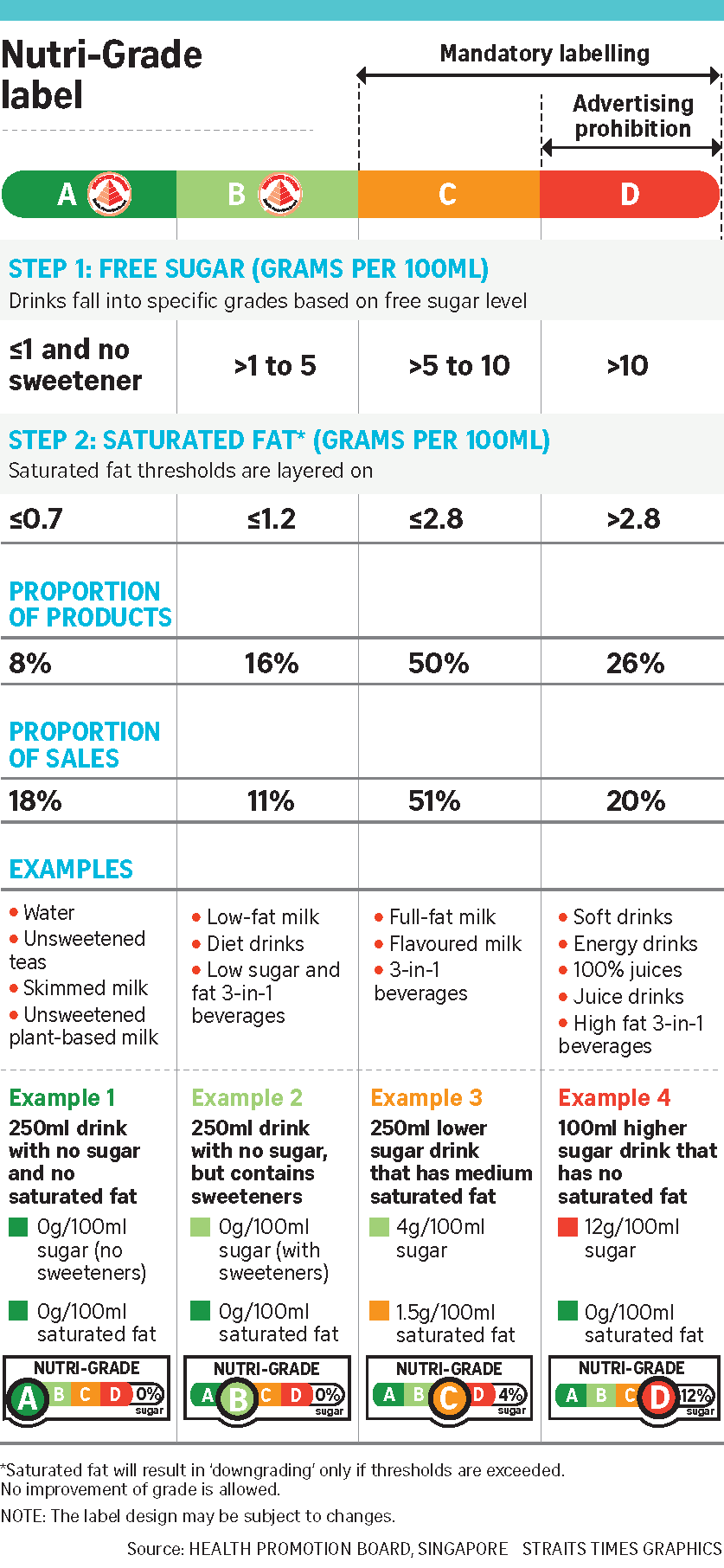Pre-packaged non-alcoholic drinks with high sugar or saturated fat content will be required to display a standardised nutrition label from end 2021 onwards.
Called ‘Nutri-Grade’, the labels will enable consumers to compare different products by providing an at-a-glance summary of the nutritional quality of the drink, as well as the sugar level as a percentage of the total volume.
The nutrition labels will have four colour-coded grades from green to red, with the letters ‘A’ to ‘D’ reflecting the sugar and saturated fat content.
It will be mandatory for drinks graded ‘C’ or ‘D’ to display the Nutri-Grade labels — about 70 per cent of pre-packaged drinks in Singapore currently fall into this category.
Advertising of grade ‘D’ drinks will be banned on all media platforms, but will still be permitted at retail points of sale.
For drinks graded ‘A’ or ‘B’, display of the label is voluntary. The Health Promotion Board’s (HPB) Healthier Choice Symbol guidelines will also be revised to align with the new grading system, with only these drinks being eligible.
Senior Minister of State for Health, Mr Edwin Tong said, “We want to encourage manufacturers to reformulate. The point is not to deprive Singaporeans of their favourite drinks, but to encourage manufacturers on their journey to reformulation to create a wider range of healthier beverages for all to enjoy.”
“All these initiatives are part of a longer-term approach to reshape consumer behaviour towards healthier living, not just in the choices that they make but in consumption,” said Mr Tong.
“[The grading system] will clearly send an indication to the industry that there’s a need to reformulate so their drinks don’t fall into the unhealthy bands of ‘C’ and ‘D’.
But equally, there’ll be a signalling to the public, to remind them which products are healthier and less healthy,” said Dean, Professor Teo Yik Ying.
Prof Teo also noted that the labels are not the final instrument, and added, “If after a couple of years of evaluation, the situation doesn’t improve, there may be a need to implement a sugar tax… something governments (elsewhere) have done.”
Health Minister Gan Kim Yong said, “To win the war on diabetes, we will need concerted, multi-year efforts, and many of these will only bear fruit in the long term. Singaporeans spend about 10 years of their life in ill health, and the battle against diabetes is part of efforts to reduce the burden of chronic disease here.”
Scientific evidence shows that drinking too many sugar-sweetened drinks leads to more weight gain and a higher risk of diabetes, said Professor Rob van Dam, Domain Leader (Epidemiology).
He added that too much saturated fat raises the level of bad cholesterol, which can also increase the risk of diabetes.
“Often with diabetes, we think about it only as a sugar disease… but the quality of the fat in a diet is also important,” said Prof van Dam.
The grades will apply to all pre-packaged drinks, and subsequently to freshly prepared drinks, such as those from bubble tea chains, traditional medicine halls and smoothie chains. Freshly prepared drinks sold at coffee house chains will also be subjected to the same measures.
“Beverages sold at coffee house chains are likely to fall under ‘C’ or ‘D’ grade due to a heavy cream content. They may be high in saturated fat despite a low sugar content,” said Prof Teo.
Such beverages would contain saturated fat if condensed milk or milk is added. If butter or margarine is used to produce the coffee beans, the saturated fat content will be significantly higher.
To give consumers a healthier alternative, the Government has been increasing the number of water dispensers across the island. By mid-2020, water dispensers will be available at all hawker centres here, as well as more than a dozen bus interchanges and terminals.
Media coverage:
- Parliament: Pre-packaged sugary drinks to carry A to D grading by end-2021; bubble tea to follow suit, The Straits Times, 5 March 2020
- Parliament: Pre-packaged sugary drinks to carry A to D grading by end-2021; bubble tea to follow suit, AsiaOne, 5 March 2020
- 本地泡泡茶将受管制 需印营养等级标签, 8world News, 5 March 2020
- Hello Singapore (6.30pm), Channel 8, 5 March 2020
- News Tonight (10pm), Channel 8, 5 March 2020
- News Tonight (11pm), Channel U, 5 March 2020
- War on sugar: Pre-packaged drinks to be graded A to D from end-2021, The New Paper, 6 March 2020
- Bubble Tea Will Have A Nutrition Label In Future, Probably To Make Us Feel Guilty, CLEO, 6 March 2020
- Pre-packed Sugary Drinks To Be Graded A to D By End-2021, The Asian Parent, 10 March 2020
- 新加坡逐步展开“减糖行动”, People’s Daily, 18 March 2020
